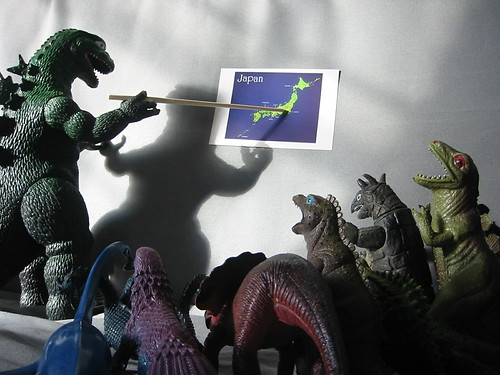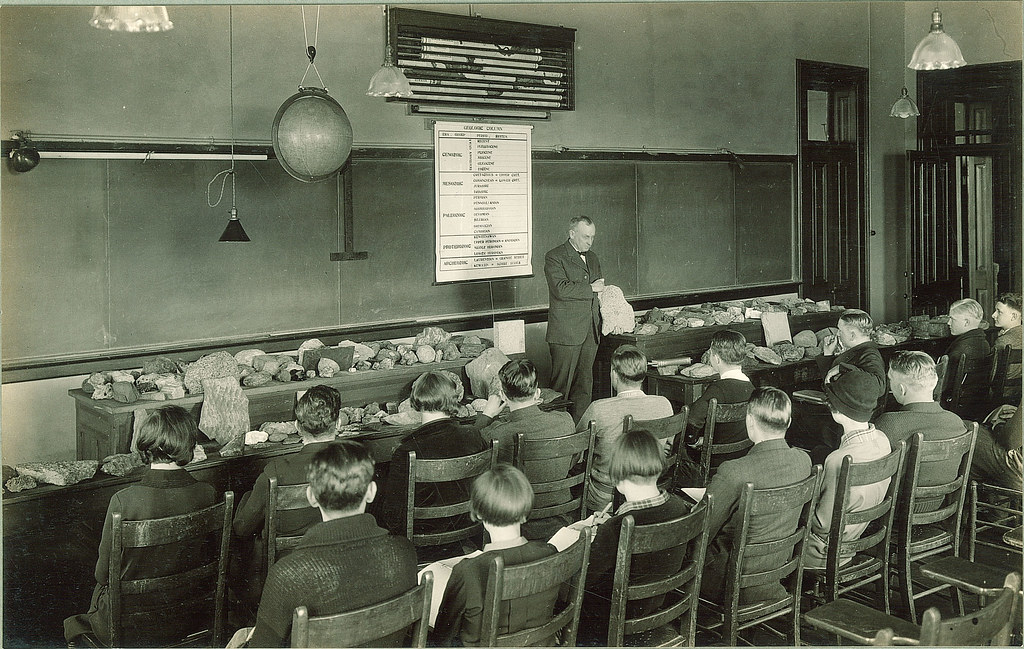Twas maybe 1994 and I went to some eLearning conference in Anaheim, probably a Masie event. I was so green (ahem like hardly even qualified to be hired) in my new role as an instructional technologist at the Maricopa Community Colleges. What did I know from conferences?
But I was horrified. Having traveled from home, sequestered in a hotel, my stomach turned as I found myself sitting in a room as someone read to me from a projected powerpoint sides on a screen.
Was this a Candid Camera stunt? Allen Funt never popped out.
Not to say that al lecture is bad, nor to diminish in any way the leadership style of a skilled teacher in the classroom, yet after decades of research (I assume) that sitting listening to THIS
is not always the most effective mode to learn. Yet… when we talk about THIS at our gatherings, we get THIS

When really THAT could be communicated just as well by THIS

Once a cc licensed ( BY ) flickr photo shared by Kenny Louie now only in the WayBack machine
I’ve whined for years about wanting to attend a conference where we did something, not talked about doing something. The closest experience I had was last month at the Mozzilla Festival in London where it was kind of like THIS for 2 days

cc licensed ( BY SA ) flickr photo shared by Alan Levine
I admit guilt at making Sweeping Generalizations Easily Shot Down, but still almost 20 years after my first academic conference experience, not much has changed in the way we do our professional communication. We do have more examples out there- unconferences, maker events, THATcamps, Edcamps… but the bulk of them are still THIS

cc licensed ( BY ) flickr photo shared by WorldIslandInfo.com
Sigh.



I think part of the problem (and there are so many problems, so many parts) is that a lot of schools have little interest in sending faculty to conferences like Mozilla Festival. The drive to publish and come away from a conference with something on your C.V. is often a pre-requisite to getting funding for travel. Which is a damn shame.
I won’t vilify the lecture here, I think for certain types of presentations it makes a lot of sense. People do also go to conferences to learn from others and in some cases that can take the form of a group of inspiring people standing beside a screen talking about a project they worked on. The majority however could be rethought in better ways if not for a lot of other driving factors that contribute to the problem.
Hi Alan,
Apple & the University of Wollongoong used to run this brilliant three day conference called the Innovative Technology Schools Conference. It was three days of hard working, exhilarating hands-on workshopping with collaboration, fun, show & tells and end products. Think it is held at the UTS in Sydney now. It was explore, trial & error, in the deep end, have a go sort of stuff.
Cheers
John
the problem isn’t powerpoint or lecture, it’s inappropriate use of powerpoint or lecture. lecture is just another word for storytelling. a properly crafted story is compelling and worthwhile. a poorly crafted one is boring, irrelevant, and unengaging.
I’ve known people who have told compelling stories for years. Some would call them lectures, but that’s not the whole story.
http://darcynorman.net/gallery/nv2008/large-39.html
http://darcynorman.net/gallery/nv2008/large-79.html
http://darcynorman.net/gallery/nv2011/large-64.html
http://darcynorman.net/gallery/nv2011/large-65.html
http://darcynorman.net/gallery/opened2009/large-7.html
http://darcynorman.net/gallery/opened2012/large-12.html
I don’t disagree however I do think there’s something to be said about the medium informing the message. Same reason I get frustrated when someone says “It’s not the tool, it’s how you use it.” Well, yes, but sometimes the tool sucks and there are better ones out there. Each choice comes with its own set of intentions and while we can fit a square peg in a round hole I don’t think that’s always the best use of anyone’s time.
Hello choir. I was trying to cover myself in the “not making sweeping generalizations” — of course there are most excellent experiences I have of listening to what I would call a lecture. I would gladly sit for hours listening to Gardner Campbell reading Craigslist ads or Brian Lamb mashing up whatever or (lots of names to fill in).
And as D’Arcy suggests its not the mode thats the problem (insert Pogo reference). We can all amp up our presentation game.
This all happened because I was truck looking at the thumbnails for the open ed archives, that if you stepped back and fuzzed the eyes, the icons all looked the same- person + screen + back of heads. That of course is a gross insult to all the sessions, which I have not listened too.
The conference format as a whole may not change much, Tim. There is no reason why people cannot still write papers and prepare content that are CV worthy, and attend conferences. The thing is, do they have to do the equivalent of reading us the paper? Is that the best use of time (and money spent traveling) together? Or when done in an online session? No, we will likely not see EDUCAUSE done Mozfest style, but we can tinker on the edges and seams of that. Stuff like UMW does with the “Carnival”.
And we can personally check what we can do with that 45 minute time slot under the fluorescent lights while the Conference Chicken(th) simmers — what still resonates with me, and shaped some of my recent approaches is Kathy Sierra’s “Presentation Skills Considered Harmful” http://seriouspony.com/blog/2013/10/4/presentation-skills-considered-harmful
Easy fixes, off the top of my head:
* mandate a short format for presentations. 10 minutes max. Pechachkashakalakadingdong.
* have people present someone *else’s* work. 5-10 minutes slots. what’s cool about what someone else’s project?
* flipped conference. do the talking-head-presentations ahead of time. people view/review/discuss them before the conference. then F2F time can be used for more interesting things – project work, collaboration, etc…
likely a bunch of other stuff to try…
I am completely en rapport with you on this one! I suggested to Northern Voice (the year we met there) to flip my digital stortelling presentation by gathering all willing media makers at the beginning of the conference, rounding them up and sending them out over the conference and the city gathering media…then a story-making blitz for two hours before a big finale presentation of created stories.
That was a no. And you might remember the lame wrap up session where everyone actually vacated the premises an hour early. Boo! Hiss! And no, I didn’t go back the next year because It WASN’T ENOUGH FUN!
Power Point? Getouddahere!
No guts no glory, boyz!